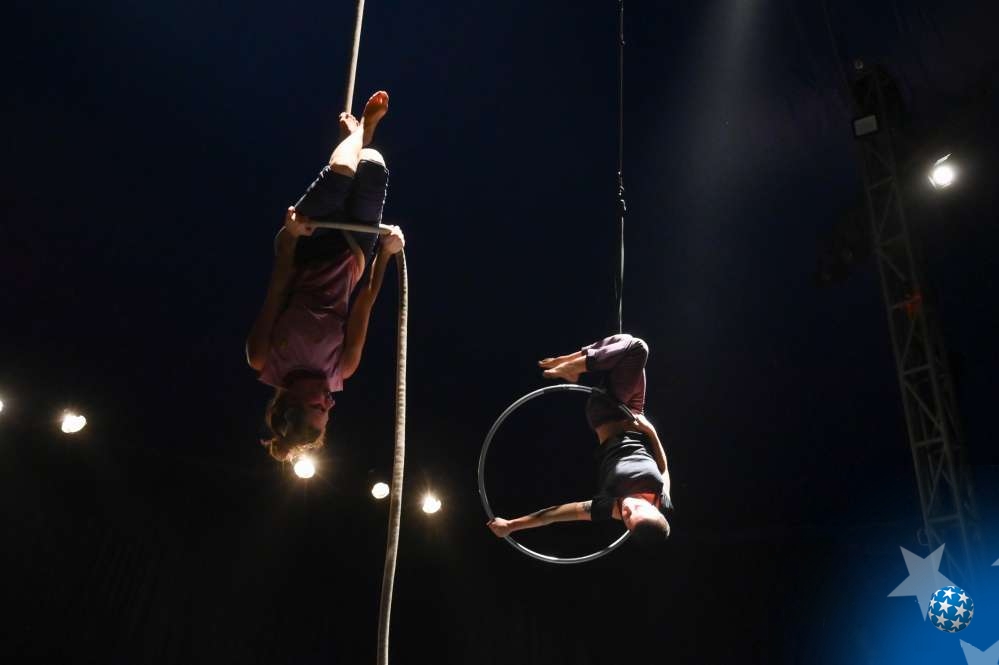Connection between contemporary circus and theatre: new tendencies and aesthetics in performing arts
At the very beginning, Bitef artistic director, Ivan Medenica, addressed the attendees and pointed out that ever since its inception, Bitef has had one central idea - to support and promote new trends in theatre and performing arts, as well as in provocative and varied forms to which contemporary circus belongs.
The discussion was moderated by Catherine Faudry, cultural attaché with the French Institute in Serbia, who called circus a live art which is in France considered extraordinary and as such appreciated and nourished, which should become a standard for Balkan countries as well.
Rosita Boisseau, the journalist with the French newspaper Le Monde, talked about the development of contemporary circus in France and its transformation from traditional circus with animals into “new circus” that does not involve them, but which involves experiments, testing the limits of human body, and exploring various new forms and connections between arts. She said that circus was an amalgam of text, music, and dance, and that it can contain many hybrid forms - circus combined with puppetry, theatre, dance, sport… In that sense, circus is a laboratory which brings together various arts, and is therefore a platform which links various artists and breaks through the barriers between them.
One of the speakers was also Philippe Quesne, French director whose performance Farm Fatale was shown last night in Bitef main programme. It is a postapocalyptic, Beckettesque story in which five scarecrows, using their bodies and surrounding objects, reflect on important environmental and social issues. Quesne talked about the relationship between artist’s body, as his primary means of expression, and the surrounding material objects, and other things. The body must be alert and capable of doing inconceivable things, circus is a serious art and asks for demanding dance, physical effort, and must be trained since early childhood, with strict discipline and determination. Quesne called trial and error the main circus principle, since it is a live performance in action, on stage, stating that artists often use dangerous objects, and that this sort of performance is a unique experiment whose outcome remains uncertain until the very end.
About risk and its necessity in circus, spoke Vanessa Silvy from the French Institute in Paris. Circus is a form that is constantly changing and developing, while always offering excitement to the audience. Tension over the possibility of failure is in its core, which is yet another crucial element in relationship with the audience. The feeling of tension is, therefore, often artificially induced by false failures and deliberate falls, so that the thrill over the successful attempt would be even bigger. She continued to speak about the importance of international cooperation and bringing together circus artists from various cultures, considering their differences, which would make sharing of knowledge and mixture of various techniques crucial for further development of circus art.
In that context, Milan Manić, as a circus artist, talked about his experience and cooperation with French artists who recognized enormous enthusiasm and desire to learn in Serbia, and offered considerable help and support to local artists who received their circus education in the streets and workshops. He talked about the problem of education of local audience, who still see circus as a traditional form, and about the necessity to support circus as an art form, not only by the audience but by official institutions as well. If circus is “theatre for people”, or rather “people’s art”, then the audience should feel close to it, and the only way to achieve that is education. That process, however, is neither short nor easy, it requires a change in the way of thinking among several generations of local audience, and Cirkusfera and Cirkobalkana, as currently the only Serbian circus festival, represent giant steps in that direction.
Bitef Blog asked a question about the attitude of circus art towards digitization, technology and new virtual art forms that developed in the pandemic. Those forms are harbingers of the world in which the carnal is no longer in the spotlight but can be substituted. Vanessa Silvy responded by giving examples of circus artists who, during the pandemic, managed to work and hold performances without artists being in front of the audience. Although they received good reactions, she does not think that body can be digitized, and that it jeopardizes the relationship between artist and the audience, plus that a circus can convey its message only via direct contact.
Duel
As a proof of a valuable international cooperation between circus artists (Cirkusfera - Serbia, Cirkorama - Croatia, and Un Loup pour l'Homme - France), Bitef side programme premiered the performance Duel, which received standing ovations, accompanied by sighs, laughter and frequent rounds of applause, since the four performers kept us at the edge of our seats with their acrobatics in the Cirkobalkana’s big top.

